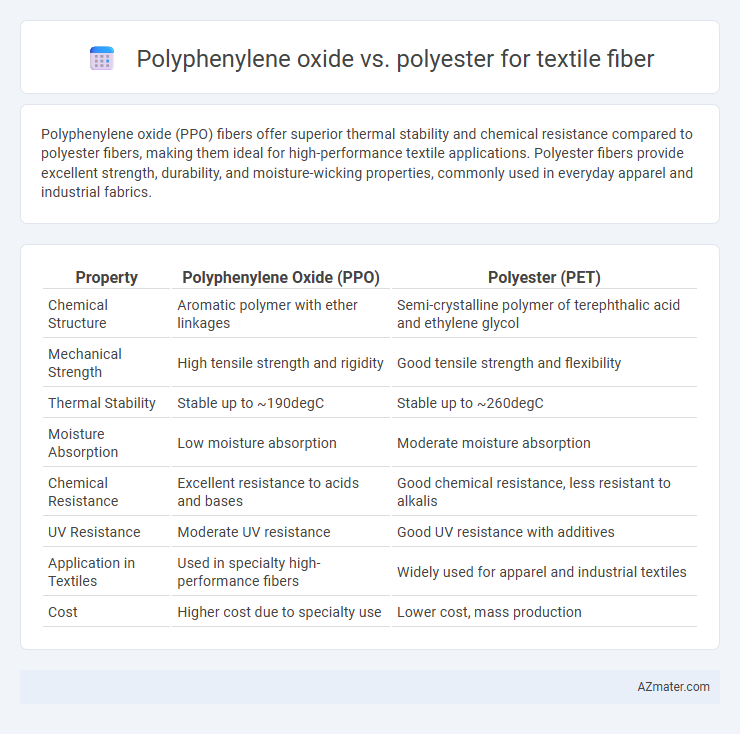Polyphenylene oxide (PPO) fibers offer superior thermal stability and chemical resistance compared to polyester fibers, making them ideal for high-performance textile applications. Polyester fibers provide excellent strength, durability, and moisture-wicking properties, commonly used in everyday apparel and industrial fabrics.
Table of Comparison
| Property | Polyphenylene Oxide (PPO) | Polyester (PET) |
|---|---|---|
| Chemical Structure | Aromatic polymer with ether linkages | Semi-crystalline polymer of terephthalic acid and ethylene glycol |
| Mechanical Strength | High tensile strength and rigidity | Good tensile strength and flexibility |
| Thermal Stability | Stable up to ~190degC | Stable up to ~260degC |
| Moisture Absorption | Low moisture absorption | Moderate moisture absorption |
| Chemical Resistance | Excellent resistance to acids and bases | Good chemical resistance, less resistant to alkalis |
| UV Resistance | Moderate UV resistance | Good UV resistance with additives |
| Application in Textiles | Used in specialty high-performance fibers | Widely used for apparel and industrial textiles |
| Cost | Higher cost due to specialty use | Lower cost, mass production |
Introduction to Polyphenylene Oxide and Polyester Fibers
Polyphenylene oxide (PPO) fibers are known for their exceptional thermal stability, resistance to oxidation, and dimensional stability, making them suitable for high-performance textile applications in demanding environments. Polyester fibers, predominantly polyethylene terephthalate (PET), offer excellent mechanical strength, chemical resistance, and versatility, making them the most widely used synthetic fibers in textile manufacturing. Differences in molecular structure between PPO's aromatic backbone and polyester's ester linkages result in distinct performance characteristics influencing their selection for specific textile uses.
Chemical Structure Comparison
Polyphenylene oxide (PPO) features a backbone of repeating phenylene units linked by ether oxygen atoms, providing high thermal stability and chemical resistance, which is essential for durable textile fibers. Polyester fibers are composed of ester functional groups linking aromatic or aliphatic units, typically derived from terephthalic acid and ethylene glycol, offering excellent mechanical strength and moisture resistance. The aromatic ether linkages in PPO result in superior oxidative stability, whereas polyester's ester bonds are more prone to hydrolytic degradation, influencing the fiber's longevity in various textile applications.
Physical Properties of PPO and Polyester
Polyphenylene oxide (PPO) fibers exhibit high thermal stability, excellent dimensional stability, and superior resistance to moisture and chemicals compared to polyester fibers. Polyester fibers provide greater tensile strength and elasticity, offering better durability under mechanical stress but lower resistance to high temperatures than PPO. The lower moisture absorption and higher rigidity of PPO make it ideal for applications requiring stable performance in harsh environments, while polyester's flexibility and abrasion resistance suit dynamic and stretch-demanding textile uses.
Mechanical Strength and Durability
Polyphenylene oxide (PPO) fibers exhibit superior mechanical strength and enhanced resistance to environmental degradation compared to polyester fibers, making them ideal for high-performance textile applications. The inherent rigidity of PPO's aromatic backbone contributes to greater tensile strength and dimensional stability under stress. Polyester, while offering good durability and cost-effectiveness, typically shows lower resistance to UV exposure and oxidative damage, which can reduce its long-term mechanical integrity in demanding conditions.
Thermal Stability and Heat Resistance
Polyphenylene oxide (PPO) exhibits superior thermal stability compared to polyester, maintaining structural integrity at temperatures exceeding 250degC, which makes it ideal for high-heat textile applications. Polyester fibers typically withstand temperatures up to 150-200degC but tend to degrade or melt under prolonged exposure to higher heat. The enhanced heat resistance of PPO contributes to its use in technical textiles requiring long-term performance in extreme thermal environments.
Moisture Absorption and Breathability
Polyphenylene oxide (PPO) fibers exhibit low moisture absorption due to their hydrophobic molecular structure, making them highly resistant to water and ideal for moisture-wicking textiles. Polyester fibers also have low moisture absorption but tend to trap more heat and moisture compared to PPO, resulting in comparatively lower breathability. PPO's superior breathability and moisture management stem from its unique polymer composition, which enhances air permeability in textile applications.
Dyeability and Color Fastness
Polyphenylene oxide (PPO) fibers exhibit superior dyeability compared to polyester due to their polar molecular structure, which allows better interaction with a wide range of dyes, especially acid and disperse dyes. Polyester fibers, being hydrophobic and crystalline, have limited dye uptake and require high-temperature processes or carriers for effective dyeing, often resulting in less vibrant colors. In terms of color fastness, polyester demonstrates excellent resistance to washing, light, and abrasion, whereas PPO fibers may exhibit moderate color fastness, necessitating specialized treatments to enhance durability.
Applications in Textile Industries
Polyphenylene oxide (PPO) fibers offer superior thermal stability and chemical resistance, making them ideal for protective clothing and industrial textiles requiring durability under harsh conditions. Polyester fibers dominate the textile industry due to their excellent moisture-wicking properties, elasticity, and ease of dyeing, widely used in activewear, upholstery, and fashion garments. The choice between PPO and polyester in textiles hinges on specific application needs such as flame resistance, mechanical strength, and cost-efficiency.
Environmental Impact and Sustainability
Polyphenylene oxide (PPO) fibers exhibit superior chemical resistance and durability, contributing to longer product life cycles and reduced waste compared to polyester fibers. Polyester production relies heavily on fossil fuels and involves energy-intensive processes that release significant greenhouse gases, whereas PPO fibers can be engineered for recyclability and lower environmental impact. The biodegradability of polyester remains limited, leading to microplastic pollution concerns, while PPO's advanced polymer structure offers potential for eco-friendly innovations in textile sustainability.
Cost Efficiency and Market Availability
Polyphenylene oxide (PPO) fibers exhibit higher production costs compared to polyester due to complex manufacturing processes and limited sourcing, impacting their cost efficiency negatively. Polyester fibers dominate the textile market with extensive availability and lower raw material and processing expenses, making them the more cost-effective choice for large-scale textile production. Market distribution data indicates polyester holds over 70% share in synthetic fibers, reflecting superior accessibility and cost advantages compared to the emerging PPO fibers.

Infographic: Polyphenylene oxide vs Polyester for Textile fiber
 azmater.com
azmater.com